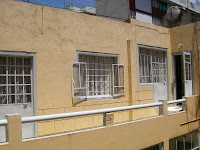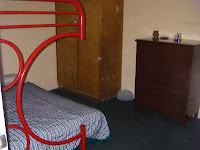Just after midday, the hot humid air hit me in the face as we walked down the stairs of the airplane in Tapachula, a border town in southern Mexico in the state of Chiapas. The hour and a half flight from the altitude of Mexico City did not prepare me for the change in scenery and climate as I descended into the bustling border town.
Luis, a Guatemalan who has been living in the border town for the last five years, met Ricardo and I at the airport. The beads of sweat running down my back quickly condensed with the air conditioning at full strength in the Toyota pickup in attempt to beat the 36°C or 37°C heat. The road to the International Organization for Migration (IOM) office was lined with banana trees and the lush greens of the tropics.
Luis works for the IOM in Tapachula, whose office opened in 2005. He is a humble man with a clear dedication to his work. The IOM is an international organization with two offices in Mexico. We visited the Mexico City office in early February and were on our way to the Tapachula office to discuss the work of IOM in southern Mexico and to gain a better understanding to the reality of migration in Mexico.
The IOM creates a network of organizations among all sectors, churches, NGOs and consulates working to create a more humane migration process. Their approach to the issue of migration is to recognize that it is impossible to stop migration. People will continually strive to improve their living situation and their opportunities which will lead them to migrate. However, the barriers and high costs to migration include abusive treatment, loneliness and lack of choice and resources. The work of the IOM is to create an environment of safety and dignity for those who migrate.
The question of migration in Mexico is as diverse as the landscape. There are Mexicans migrating internally, to tourist areas or large cities. There are Mexicans migrating to the United States, both legally and illegally. There are Central Americans on their way through Mexico to the Unites States. And in this variety of transit there are numerous reasons for moving and innumerable potential dangers for migrants, both Mexicans and those from other Central American countries. Too often the focus of migration is from the perspective of the developed countries that receive immigrants; however the reality for thousands in Mexico and along the southern Mexican border is not portrayed in the media which is quick to focus on and criminalize the migrants crossing the militarized and dangerous northern border.
As MCC Mexico investigates the potential for work in the area of migration, it is helpful to remember that multiple types of migrants in Mexico.
- Internal Migrants
According to the 2009 Human Development Report most of the movement in the world does not happen between developing and developed countries, rather within countries. A conservative estimate is that approximately 740 million people are internal migrants in the world; almost four times as many as those who have moved internationally. According to the same report there is almost double the amount of people in Mexico who move internally than internationally.
- External Migrants
The public is most familiar with the immigrants who are crossing borders in search of better conditions and economic opportunities. Communities across Mexico are faced with a varying degree of emptiness as youth, men, and women leave behind their families to attempt crossing the much militarized US and Mexican border. Among states with highest expulsion rates in Mexico are Guerrero and Chiapas, where MCC Mexico has worked and built relationships with communities.
- Migrants in Transit
In comparison to the overwhelming number of people who move within countries, the number of immigrants who cross borders in the world, 214 million, looks relatively small. Among those who move internationally, just over a third moved from a developing country to a developed country, fewer than 70 million people. In 2008 according to the Migration Policy Institute, an estimated 11.4 million people migrated to the US; however in light of the recent recession, immigration trends are slowing.
There are Mexicans who migrate to the North, with all of the dangers at the northern border, as well as migrants from Central and South America who are in transit through Mexico. With the militarization of the northern border, some migration workers suggest that the southern Mexican border is the new US border. Many Central American migrants face a host of dangers and potential traps as they progress through Mexico. The chance to attempt a northern Mexico border crossing means that the migrants have completed a lengthy and difficult journey through Mexico that most likely included violence and aggression of some type, be it theft, sexual aggression or labour exploitation.
- Migrants who Return
The economic crisis in the US has forced many migrants to return to their communities. These migrants have spent time away from their community and have been exposed to a variety of new ideas and experiences. There are positive and negative consequences to this separation. At best, the migrants work to improve the services in the community; however, there is a real danger that the separation makes it difficult for the migrants to integrate into family and community life. The families who remain and the migrants lose a valuable connection that provides the stability that can strengthen and build the community. Communities lose the cultural norms and traditions that unite and fortify the community with continual leaving and returning. This disruption has the potential to lead to a disintegration of families and communities.
- Circular Migrants
Finally, circular migration is a topic of importance especially for those living along the border. Long before borders were established through wars, treaties and governments, communities who now live along country borders maintained trading and communication routes which were disrupted by arbitrary boundaries.
Agreements between Mexico and Guatemala provide border residents legal passes to cross freely through the borders for temporary agricultural work or temporary visitor passes. However, there is also a marginalized sector who work in domestic service and factories that are exploited and experience grave abuses of human rights. This sector is difficult for organizations to work with as they are often invisible due to long work hours and hesitant to speak out against their exploitation.
After less than six hours in the southern town, it was time to migrate north. As I climbed the steps of the bus for the five hour trip to Tuxtla, the capital of Chiapas, I was reminded of how easy my country traveling was despite my exhaustion.





























